| As we motored
along Brazil's Rio Negro, the largest
tributary of the mighty Amazon River, the keen eyes of our savvy
Amazon Indian guide, somehow, detected a minute opening in the
jungle foliage where none appeared to exist. Ajilson idled the
18-foot Nitro bass boat towards the dense rain forest and, after
motoring through a narrow opening between two massive trees, we
suddenly found ourselves swallowed up by the thick jungle
foliage.
A tiny creek, barely wider
than our boat, had been discovered by our
guide, affectionately called "Popcorn" by American
anglers since 1993. The creek snaked its way deep into the
verdant green forest and we could detect by his excited demeanor
that Popcorn was eager to venture ahead.
We probed deeper into the
rain forest, an area that possibly only a
few Indians had passed before us. My fishing partner Spence
Petros and I began questioning the sanity of this angling
expedition, as well our guide's sense of direction. Did Popcorn
really have a clue as to where this never-ending labyrinth of
branching creeks would lead?
Surely no one could
possibly ever find us if we really were to
get lost or break down. Would we fall victim to poison darts and
arrows from a tribe of cannibalistic Indians whose secret burial
grounds were desecrated by our presence? Our trepidations were
further enhanced when a smiling Popcorn pulled the two-foot long
sharply honed machete from its sheath that hung from his
belt.
"Eat Spence
first," I shouted to our guide, my
voice quivering in a feigned frightened pitch, "he's got
much more meat on his bones than me!" Fortunately we were
not on the menu that morning, and Popcorn used the machete not to
carve "filet of gringo," but rather to hack
through dense overgrowth, rope-like vines and toppled trees, some
as thick as 14 inches in diameter, that blocked our path on this
small creek. After approximately an hour of motoring a boat
through terrain where few American bass anglers would dare to
travel, suddenly, Ajilson ceased his incessant hacking, wiped his
machete clean and gently placed it back in its sheath. To
our delight, the narrow creek had lead us to a large lagoon that
must have been at least 25 acres in size and offered an average
depth of four feet.
Popcorn gestured for us to pick up our rods and begin fishing.
"Muito tucunare," he said. My Portuguese is decent
enough to know that the guide was referring to the fact that the
lagoon was loaded with tucunare (pronounced too-coo-na-ray), the
Brazilian term for peacock bass, and they probably have never
been tempted by an artificial lure before.
"Should have had a
fish on that cast," Spence muttered to
himself after accurately casting the big Wood Chopper surface
plug within an inch of the main trunk of a thickly branched tree
that lay toppled in the water. Although the fish failed to take
his offering as he rapidly retrieved it by the fallen tree, it
must have piqued its interest enough to entice him to follow the
plug back to the boat.
Unfortunately, the world class angler and fishing magazine
editor from Chicago wasn't aware that the fish was about to
wreak havoc on his topwater lure. The resultant collision of fish
and lure occurred just six feet from
the boat. The spectacular strike and subsequent drag peeling run
occurred so rapidly that it was out of shear reflex that Spence
kept his rod from snapping as it bent over the port-side of the
boat as he tried to slow the large male down.
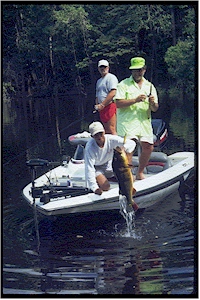 After
a two minute battle, this three foot long
package of emerald green fury was on the surface. But the
tucunare grande (giant peacock bass) wanted no part of Popcorn's
awaiting net however and he stripped off another 15 yards of drag
until Spence could turn him once more. Finally, the played out
fish was captured. The fish weighed 18 pounds on a certified
scale. He was kept out of water a moment to snap a few photos
and was released back into the tannin-stained lagoon no
worse for wear. After
a two minute battle, this three foot long
package of emerald green fury was on the surface. But the
tucunare grande (giant peacock bass) wanted no part of Popcorn's
awaiting net however and he stripped off another 15 yards of drag
until Spence could turn him once more. Finally, the played out
fish was captured. The fish weighed 18 pounds on a certified
scale. He was kept out of water a moment to snap a few photos
and was released back into the tannin-stained lagoon no
worse for wear.
Monstrous peacock bass are
the rule rather than the exception on
Brazil's Rio Negro. In fact, the world record fish (27
pounds) was landed within a mile from where Spence bagged his 18
pounder - a peacock tucunare, one of the three major subspecies
residing in Brazil's Amazon Watershed.
One Tough Hombre. Although
its basic shape demonstrates a close resemblance to the popular
largemouth bass, the peacock bass is not actually a member of the
bass family. It belongs to a family of fish known as cichlids,
one that boasts numerous species worldwide and is well known to
tropical fish enthusiasts. Like the largemouth bass, the peacock
prefers to ambush unsuspecting prey from a stealthy vantage point
and demonstrates a gluttonous appetite. The similarity ends
there, however. The peacock bass is much more eye appealing than
its North American counterpart, colorfully adorned in varying
shades of green, blue, orange and gold. It is much more
aggressive than the largemouth, often pursuing lures or fleeing
prey the same size or larger than itself.
"The peacock bass routinely breaks lines, shatters
rods and destroys tackle that would subdue the toughest
largemouth bass," says Spence Petros, an inductee into the
National Freshwater Fishing Hall of Fame. "The peacock bass
is one special gamefish to have evolved and survived in a
watershed that contains schools of hungry pirhanas, giant Amazon
catfish the size of Volkswagens, 12-foot long pirarucu with
armor-like scales, alligators and an assortment of other unsavory
characters that possess fangs, teeth and stingers."
Rio Negro Lodge. The
Rio Negro Lodge, the most comfortable sportfishing facility in
the Amazon region of South America, opened its doors to anglers
from throughout the world in October 1998. This spacious retreat,
located below the jungle canopy on the shores of the Rio Negro,
was created to provide anglers with the comforts and privacy they
expected of a luxury resort. The 5,000 square foot air
conditioned main lodge is centrally located and serves as the
gathering place for dining and relaxing. Spread along winding
walkways on either side of the main lodge are nine private
cabins, each complete with air conditioning, Queen sized beds,
private bathroom, garden tubs and stocked refrigerator.
The Rio Negro Lodge is the brainchild of Phil Marsteller,
owner of the extremely popular Amazon Queen 85-foot houseboat
that has hosted anglers since 1992. Marsteller, 43, a former
military helicopter pilot and
international airplane broker, knows the Amazon Watershed
like the back of his hand and specializes in providing anglers
with hassle-free excursions for giant peacock bass.
The location for the Rio Negro Lodge was carefully selected in
the heart of Brazil's finest peacock bass fishery and only a 20
minute boat ride from where one of Marsteller's clients, Gerald
"Doc" Lawson set the all-tackle
world record. Ten pound fish barely raise an eyebrow; 15 pounders
are commonplace and 20 pound monsters are landed with great
regularity in this fertile
fishery.
Our group met in Miami, where we boarded a Varig Brazilian
Airlines 767 jumbo-jet at 9:00 p.m.. Our flight took us, nonstop,
to Manaus, Brazil, a modern city with a population of two
million, situated at the confluence of the Rio Negro and the
mighty Amazon. We were greeted by Marsteller, an American now
living in Manaus for nine months out of the year, and his staff
and were taken for a one hour flight to the city of Barcelos. It
is estimated that more tropical fish are brought to this small
city from commercial fishermen for export internationally than
any other location in the world. The Rio Negro lodge is located
approximately 50 minutes upstream from Barcelos.
Following a brief orientation and a hearty breakfast, the
group began its week long fishing adventure. There are a minimum
of 20 employees (including guides) associated with the Rio Negro
Lodge and all have one goal in mind - to offer visiting
guest/anglers an excellent fishing vacation.
Prime Time for Tucunare.
The prime time to fish for trophy tucunare on the Rio Negro north
of Manaus is between the months of November and April. This
coincides with the Brazilian dry season on the stretch of river
north of the equator. In May, torrential rains swell the rivers,
creeks and lagoons of the northern Amazon Watershed. The jungle
is virtually inundated with thousands of acres of flooding. The
tucunare can literally hide anywhere and an abundant food source
is readily available for them in the jungle terrain. High water
is the most difficult condition to fish for the tucunare. They
are virtually inaccessible by boats and out of casting range of
anglers when back up in the trees and vegetation of the flooded
jungle.
In August or September, the rains begin to subside and the
rivers, creeks and lagoons shrink each day from the receding
water. This now positions the fish back into areas where they are
accessible to anglers. By November, the levels are usually low
enough to provide for prime fishing opportunities in the northern
Amazon Watershed. Occasionally, however, the rainy season fails
to abide by schedules and may add unexpected water to the system
during midseason downpours.
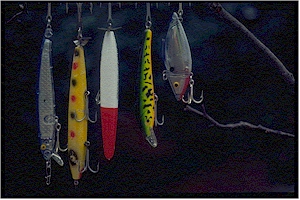 Tempting
a Tucunare. By far, the most exciting
aspect of peacock bass fishing is their propensity for
annihilating large topwater plugs. The very best for trophy
tucunare include three manufactured by Luhr-Jensen: the Big Game
Woodchopper; Magnum Jerkin' Sam and new Amazon Ripper (Marsteller's
personal favorite), as well as the Eatem-Up Monster Prop,
HighRoller Rip Roller and Temptress Lures Detonator. These large
surface propeller baits need to be worked aggressively across the
surface. Tempting
a Tucunare. By far, the most exciting
aspect of peacock bass fishing is their propensity for
annihilating large topwater plugs. The very best for trophy
tucunare include three manufactured by Luhr-Jensen: the Big Game
Woodchopper; Magnum Jerkin' Sam and new Amazon Ripper (Marsteller's
personal favorite), as well as the Eatem-Up Monster Prop,
HighRoller Rip Roller and Temptress Lures Detonator. These large
surface propeller baits need to be worked aggressively across the
surface.
Your baits should mimic the frantic escape of a fleeing
baitfish. And baitfish do, indeed, flee in this cauldron of
predators. In many instances, we observed foot-long silvery
baitfish beach themselves on sand bars to avoid a nasty demise by
a school of hungry tucunare on a feeding foray.
Cast the big topwater plugs on a stout casting rod, paired
with a baitcasting reel that possesses the ability to handle 65
to 80 lb break strength braided line. That's right, 80 lb break
strength braided line! With the temperament of an injured water
buffalo and a propensity for ambushing prey from stumps, brush
and tree root systems, these fish can make easy work of lesser
diameter lines that are not abrasion resistant. Also, these
braided lines possess very little stretch, affording anglers much
less arm fatigue when casting and retrieving large topwater plugs
a thousand times a day. The braided line is an absolute necessity
when working large topwater lures.
When the topwater action slows and fish will not feed on the
surface, switch to a jerk bait. Favorites of veteran peacock bass
anglers include Bomber Long-A Minnows, Luhr-Jensen Javelins,
Temptress Peacock Minnows and Cordell Red Fins, in chrome color
patterns with blue or black backs or chartreuse firetiger
patterns.
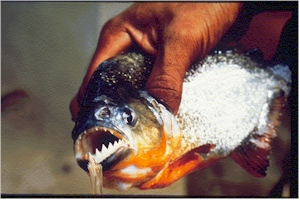 Other
Exotics. In addition to prime peacock bass
action, anglers will also enjoy catching other unusual jungle
river predators such as the arawana, pirhana and giant Amazon
catfish called the pirarara and piraiba. Other
Exotics. In addition to prime peacock bass
action, anglers will also enjoy catching other unusual jungle
river predators such as the arawana, pirhana and giant Amazon
catfish called the pirarara and piraiba.
The arawana, also called the water monkey, will strike lures
used for peacock bass. It is a prehistoric looking critter with
an eel-like tail. Pirhanas will also attack baits used for
peacock bass. Two of the very best pirhana baits are the
Rat-L-Trap and the 1/4-to-1/2 ounce white bucktail jig. Be sure
to use wire leader, approximately 6 inches of 20 lb. test, as the
ferocious dentition of these carnivores will make mincemeat out
of regular monofilament. If you really want to catch a bunch of
these toothy critters, I suggest bringing light spinning gear,
small hooks, wire leader and fish with meat on the
hook.
The giant Amazon catfish are caught on cut-bait worked on the
bottom, in or near a drop-off, during the late afternoon and
early evening hours. You need to bring saltwater gear for these
fish, as documented catches of fish in excess of 300 pounds are
not uncommon.
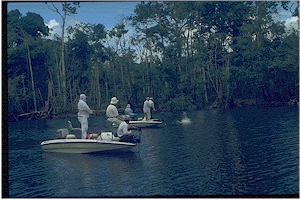
A Daily Schedule. A typical day begins
with a hearty breakfast and then anglers are paired two to a boat
with an experienced Brazilian Indian guide. Anglers fish out of
18-foot fiberglass, fully rigged American made Nitro bass boats,
equipped with trolling motors, ship to shore radios, swivel seats
and depth finders.
Anglers can fish through lunch if they desire, or can elect to
take an hour siesta on a hammock set up in the rain forest
by the guides after consuming the deli-like sandwiches packed in
coolers by the Rio Negro Lodge cooking staff. An average fishing
day is from 6:00 a.m. until 6:00 p.m.
A delightful dinner is served back at the lodge. A tasty array
of meals are prepared, including shrimp, chicken, beef barbecue,
steak and fish. Commercially purchased ice made from filtered
water is always available. The vegetables and fruits are washed
in filtered water and are safe to consume. After dinner,
it's time to take advantage of the complimentary bar and possibly
a quality cigar or two and to reminisce about the ones that got
away.
There is no need to overpack, as daily laundry service is
available. Clothes are washed, ironed and folded and neatly
placed on your bed each day.
|
Travel
Itinerary
- Monday - Miami to Manaus
- Tuesday - Early a.m.
arrival in Manaus. Change for flight to Barcelos, followed by a
boat ride to Rio Negro Lodge. Begin fishing!
- Wednesday - Fish
- Thursday - Fish
- Friday - Fish
- Saturday - Fish
- Sunday - Fish
- Monday - Flight back to Manaus.
Rest of day at leisure. Spend evening in hotel.
- Tuesday - Flight back to
USA
Included in Trip Package
- 6 Days of Fishing
- Lodging at Rio Negro Lodge
- All Meals
- Open Bar
- Soft Drinks & Bottled Water
- Boats & Guide
- Fishing Permits
- Hotel stay in Manaus
- Ground Transfers
Not Included in Trip Package
- Airport departure tax
- Gratuities
- Air Fare to Manaus
- Tackle items purchased
Booking Information
QUEST! Global Angling Adventures
3595 Canton Highway
Suite C-11
Marietta, Georgia 30066
Phone (Toll Free): 1-888-891-FISH
E-mail: Questhook@AOL.COM
Trip Summary
Boats - 18-foot fiberglass
American made Nitro bass boats with 75 hp Mariner outboards.
Trolling motors, depthfinders, swivel seats and ship to shore
radios.
Food - Tasty breakfasts and
dinners (all you care to eat). Lunch consists of thick cold cut
sandwiches on the water. Coolers are packed with water, beer and
soft drinks and filled to the top with ice. Open bar.
Insects - Mosquitoes are not a
factor in the Amazon Watershed. The blackwater river system
found here is not conducive to mosquito growth.
Travel Precautions - Check with a
travel medicine clinic for necessary inoculations and
anti-malarial medications. We will provide you with the latest
data from the Centers for Disease Control.
|
Without question, the
Rio Negro Lodge is the most comfortable way to fish the tropical
climate of the Amazon Watershed.
Weekly trips to the Rio Negro Lodge and the Amazon Queen are
booked to 90% capacity one year in advance. If you would like to
fish the Amazon Watershed at the Rio Negro Lodge, anglers should
consider booking 8 to 12 months in advance.

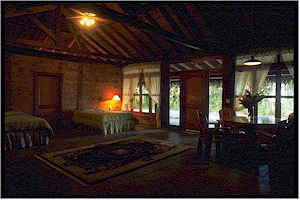
* Gary Laden can be read in just about every fresh water
fishing publication in America and several overseas. He is the
former fishing columnist for the Atlanta Journal newspaper. He is
a contributing writer to the IGFA World Record Book. Gary is the
angling travel editor for America Online's Fishing Broadcast
Network (FBN). If you have any specific questions about the Rio
Negro Lodge, please contact Gary at Fishwriter@aol.com
|
